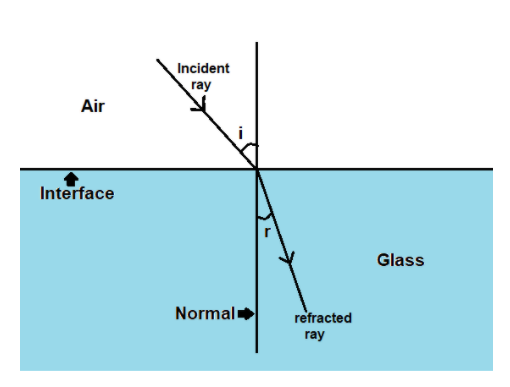
A ray of light travels from air to glass at an angle of incidence of
A. 0.66
B. 0.133
C. 1.5
D. None
Answer
482.1k+ views
Hint: Glass is a denser medium and air is a rarer medium, therefore when light ray travels from air to glass then the refracted ray bends towards the normal. Refractive index of glass can be calculated from Snell’s law which is the ratio of sine of angle of incidence to sine of angle of refraction.
Complete step by step answer:
We are given to find the refractive index of glass when a ray of light travels from air to glass at an angle of incidence of

Snell’s law is used to describe the relationship between angle of incidence and angle of refraction. It states that the ratio of the sine of angle of incidence to the sine of angle of refraction is always a constant. And this constant is called a refractive index.
The angle of incidence is the angle between incident ray and the normal represented using ‘i’; the angle of refraction is the angle between refracted ray and the normal represented using ‘r’.
Refractive index of the glass (
Therefore, the correct option is Option C, 1.5.
Note: Do not confuse refraction with reflection. Where reflection happens in only one surface and refraction happens in two surfaces. For example reflection is seen in mirrors and refraction in lenses (lenses are made of two curved surfaces). Bending of light can be observed in refraction but not in reflection. Angle of incidence is the same as angle of reflection but angle of incidence is different from angle of refraction.
Complete step by step answer:
We are given to find the refractive index of glass when a ray of light travels from air to glass at an angle of incidence of

Snell’s law is used to describe the relationship between angle of incidence and angle of refraction. It states that the ratio of the sine of angle of incidence to the sine of angle of refraction is always a constant. And this constant is called a refractive index.
The angle of incidence is the angle between incident ray and the normal represented using ‘i’; the angle of refraction is the angle between refracted ray and the normal represented using ‘r’.
Refractive index of the glass (
Therefore, the correct option is Option C, 1.5.
Note: Do not confuse refraction with reflection. Where reflection happens in only one surface and refraction happens in two surfaces. For example reflection is seen in mirrors and refraction in lenses (lenses are made of two curved surfaces). Bending of light can be observed in refraction but not in reflection. Angle of incidence is the same as angle of reflection but angle of incidence is different from angle of refraction.
Recently Updated Pages
Master Class 11 Economics: Engaging Questions & Answers for Success

Master Class 11 Business Studies: Engaging Questions & Answers for Success

Master Class 11 Accountancy: Engaging Questions & Answers for Success

Master Class 11 English: Engaging Questions & Answers for Success

Master Class 11 Computer Science: Engaging Questions & Answers for Success

Master Class 11 Maths: Engaging Questions & Answers for Success

Trending doubts
State and prove Bernoullis theorem class 11 physics CBSE

1 ton equals to A 100 kg B 1000 kg C 10 kg D 10000 class 11 physics CBSE

State the laws of reflection of light

One Metric ton is equal to kg A 10000 B 1000 C 100 class 11 physics CBSE

1 Quintal is equal to a 110 kg b 10 kg c 100kg d 1000 class 11 physics CBSE

Difference Between Prokaryotic Cells and Eukaryotic Cells




